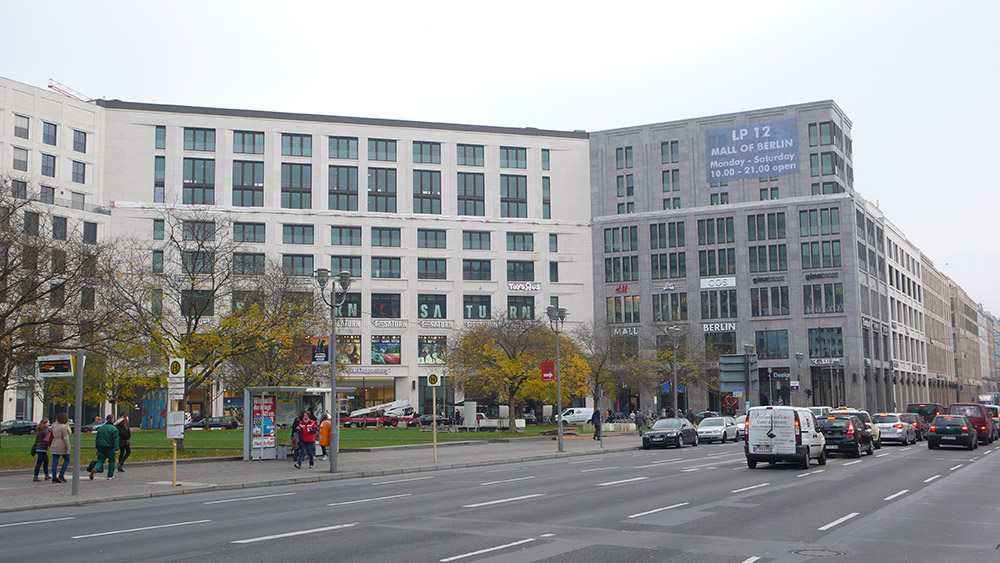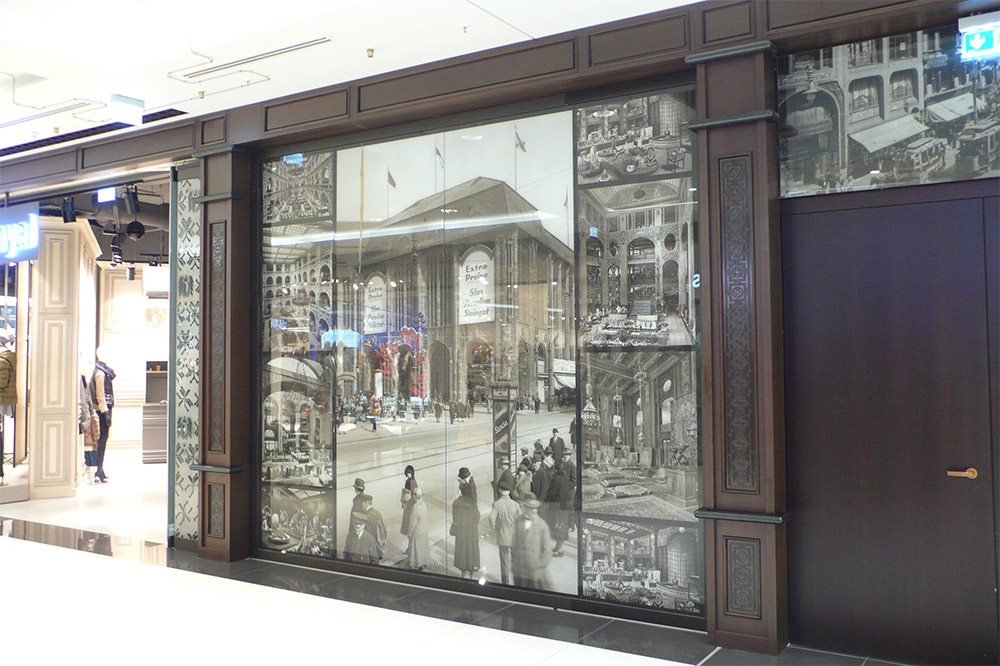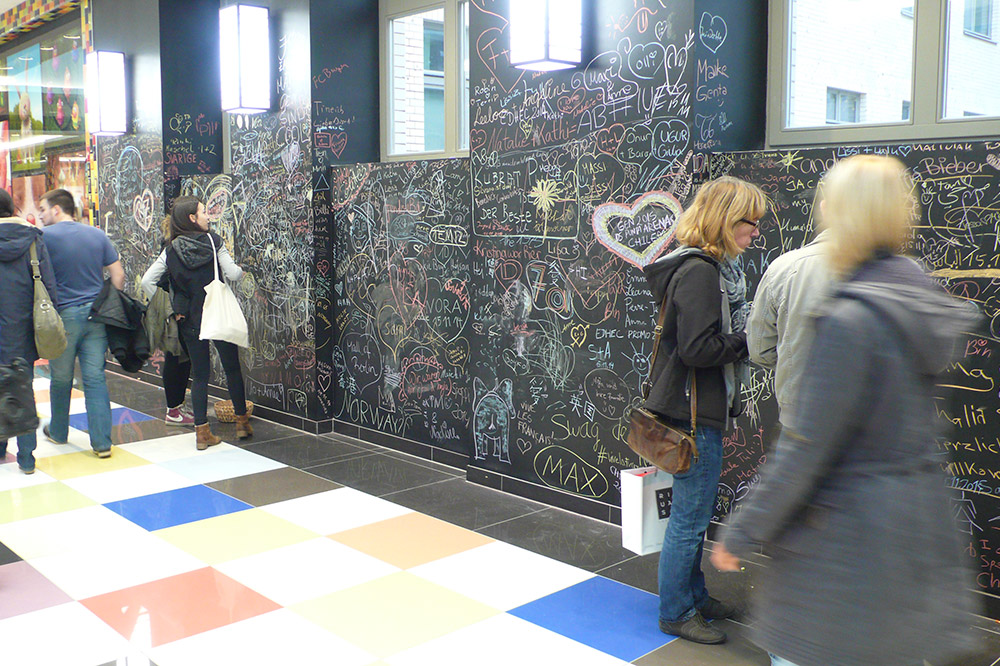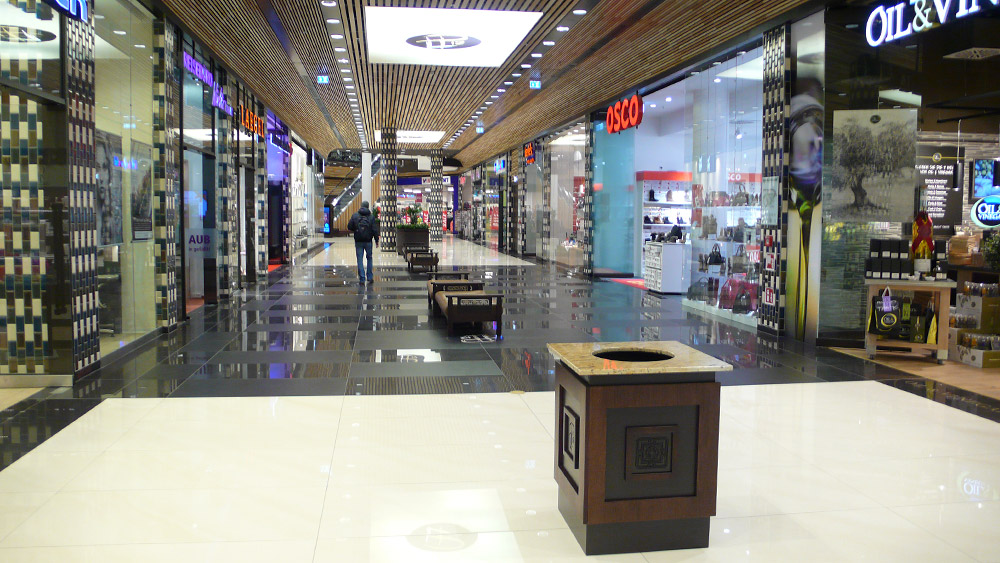The myth and the mob
The Mall of Berlin is 76,000 m² of new retail space built on the former site of the Wertheim department store on Leipziger Platz, which was once the largest of its kind in Europe. The Wertheim building was partially destroyed by Allied bombs in 1944; nothing less than the Führerbunker skulked some meters to the North. Wrecking balls followed in 1955 and six years later the Berlin Wall went up, casting the plot deep into no-man’s-land. The new complex boasts 270 shops, with as many apartments located on the upper three floors. It occupies two city blocks on an east-west axis, and is bisected north-to-south by a glass-roofed atrium.
“Shopping is coming home”, declares the publicity material, in English. That’s one thing residents of this town have had to get used to over the last few years: a fetishistic clamouring to the Anglo-Saxon by property developers, who only seem capable of focussing on Berlin through the lens of other places. For this reason you also have the sphincter-clenching embarrassment that is the Upper East Side commercial development on Unter den Linden. In reunified Berlin, there is nothing east nor upper about it, either geographically or stylistically.
Here though, the unmistakable reference to the Mall of America is presumably meant as a gesture of self-possessed internationalism, but it comes across as a corny admission of inadequacy. The Minnesotan namesake is content to call itself MOA on occasion. MOB, though, just sounds second-rate, and carries a worrying lexical payload for anyone sensitive to the power of the crowd. Sensing this problem perhaps, the Mall of Berlin plays it safe with a dumb little fall-back name of its own: LP12. It’s an acronym of the street address, Leipziger Platz 12, and the contraction is a popular naming strategy across town for businesses lacking in imagination: tacky hairdressers, low-rent ad agencies or third rate bakeries trade under similar names, not 800-million-Euro shopping malls.
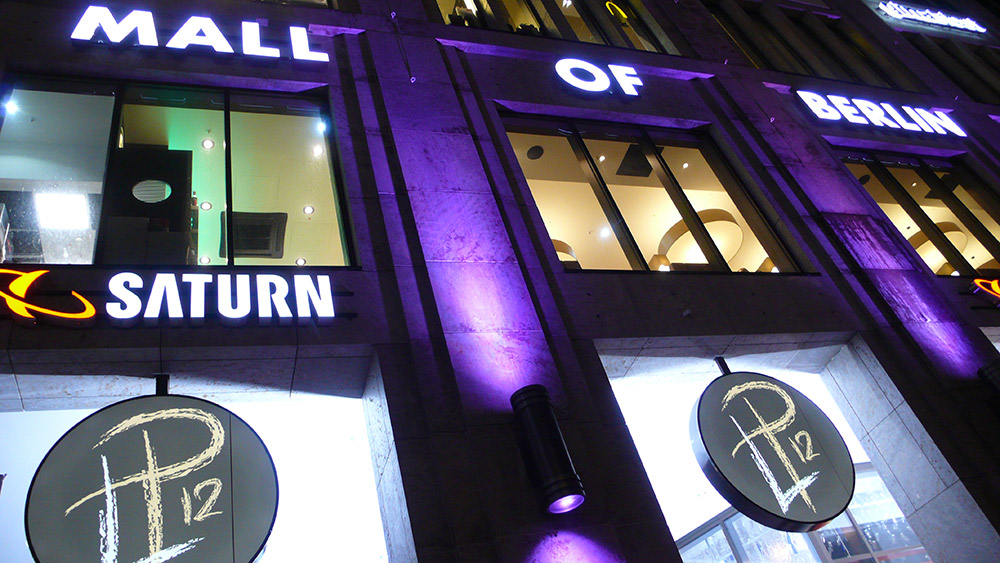
A lighting suggestion for natural stone façades
Outside, the Mall of Berlin adheres to the dutiful blend of gestures which defines post-unification architecture in Berlin. A stiff grid of windows punctures a sandstone and granite curtain: the flush fit of the glass rules out any playful syncopation of light and shadow, creating the architectural equivalent of marching music. Funk, or swing, is eschewed in favour of a barely perceptible shifting of the surface plane. The proportions of the windows vary across the building’s height, compressing the central floors of the sandstone-coated segment, and stretching them in the granite portion. Equally, the windows of the upper floors either squint myopically or dilate unblinkingly. Not only are these tectonic trompe l’oeil entirely divorced from the logic of the inner structure, they are also so restrained that it is difficult to perceive any stylistic intention in them. They are subliminal ripples on the surface, reporting of unseen turbulences below. What remains is the lingering sense of something which has been overstuffed, and is ready to burst: an engorged Weisswurst perhaps, or the ripening carcass of a beached whale.
On reading that architects Tchoban Voss were partly responsible, I actually gasped audibly. I only knew them from their project Museum for Architectural Drawings in Prenzlauer Berg, where I’d caught a Lebbeus Woods exhibition last summer and been overwhelmed by the dense opulence of their vault-like structure: a petrified palimpsest. Something surely had gone amiss. Alas no. For the Mall of Berlin, Tchoban Voss worked with Pechtold Architects, whose portfolio reads like an illustrated lexicon of everything people mean when they refer derisively to Investorenarchitektur (investor’s architecture). The much criticised, abhorrent little box of a hotel on Hauptbahnhof is by Pechtold, as is the Greco-Roman-Egyptian-Polymer mashup, Schlossgalerie Berlin-Steglitz. On further inspection, Tchoban Voss’ museum is an oddity or fluke: the detested Eastside Tower, which went up on the site of the East Side Gallery amid significant protests in 2012 is from their stable. So too the inner-city branch of Ikea which opened amid significant protests in the Altona district of Hamburg last year. Recent reports suggest it sells little furniture, but has become a block-sized hotdog stand with an empty parking garage where school-kids come to make selfies.
Peculiar nooks of dead-space can be found at LP12 too. I tried to outsmart the building by entering it not from the atrium, nor from the main entrance, but via an alleyway between the service doors and ventilation slats which line Leipziger Straße. For this is LP12’s contribution to urbanity in Berlin’s city center: instead of window shopping, you can just go vent-sucking.
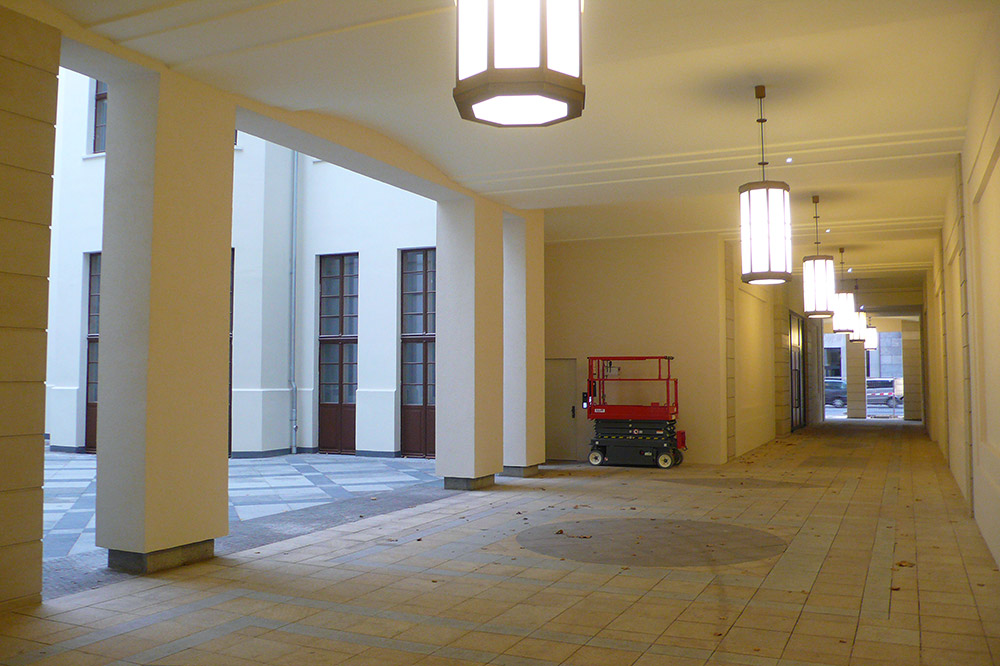
Obvious to me now: not the entrance
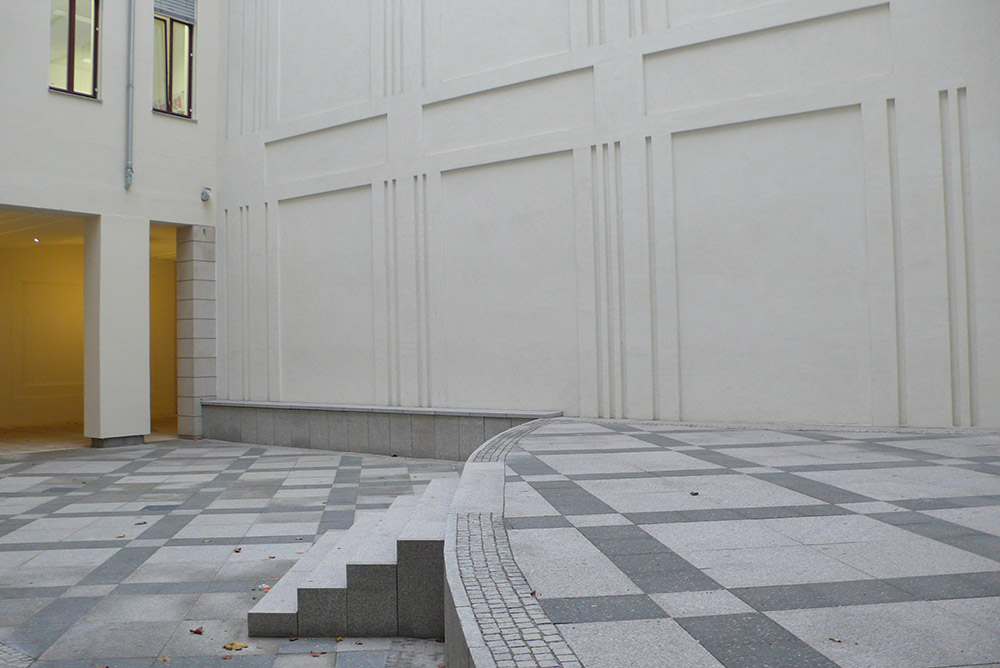
Step right up: a master course in SLOAP (Space Left Over After Planning). The dead-space of an accidental courtyard, where leaves come to rustle.
I had hoped to circumnavigate the crowds and spirit myself inside via a hatch or similar unmarked portal, materialising perhaps in a broom cupboard. The alleyway was lit by lamps made for a space with twice the headroom, and led passed an odd little courtyard with a bandstand-like stage area. Aside from allowing a little light to pass into the office windows, it was difficult to imagine any immediate function for the space, though it did give pause enough for me to admire a set of columns resting on their emaciated anti-plinths; a very contemporary negotiation between ground and building. Further on I found a door, which was glazed but locked from the outside, and no amount of manipulation was going to convince a button mounted at hip-height to open them. Shoppers on the other side gazed at me, first with an expression of opportunistic appeal as though they wished to escape, then with contempt when it was clear that I had no more authority in the matter than they did.
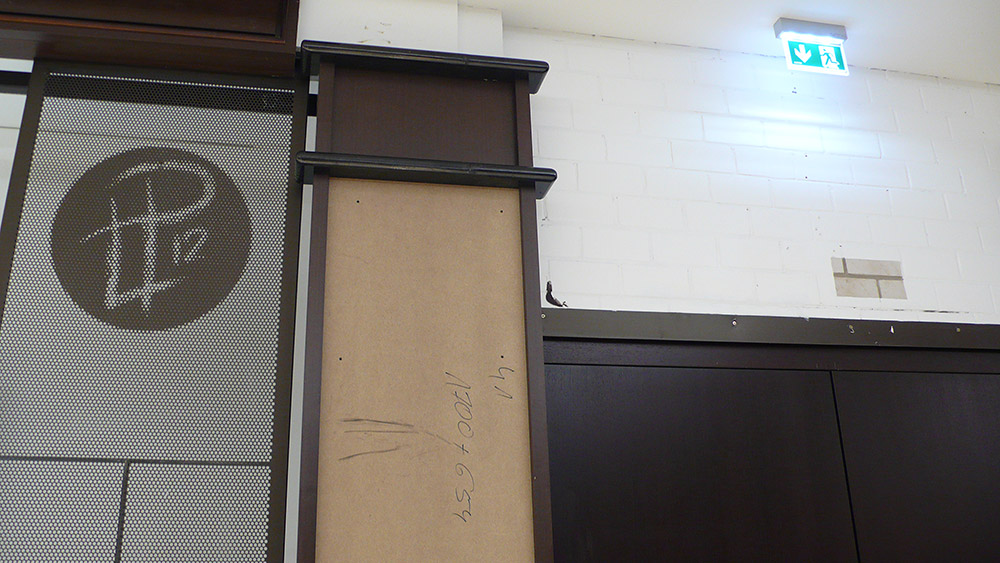
An accumulation of surfaces posing as mass
Inside LP12, space, depth and mass seemed overwhelmed by the sheerness, or over-abundance of surface. Repeat-pattern floral entablatures, which might have been carved in Wertheim’s day, appear as stick-on decals, laser cut from laminates and rolled into place with two-component epoxy adhesives. Wafer-like fake-mahogany veneers coat the seams between floor, wall and ceiling. Mirror-polished marble is the zero-depth floor surfacing of choice, fitted as precisely as the pixels on a hi-res laptop display. It is there to reflect the ceiling spots, the ambient shop lighting and the LED-juiced signage, and levitates the shopper on a cushion of pure glare. The white ceiling is cross-illuminated to eradicate any clues as to its elevation, and acts as a bright stream pulling you through a one-point-perspective corridor coiled into a loop like a three-floor Möbius strip.
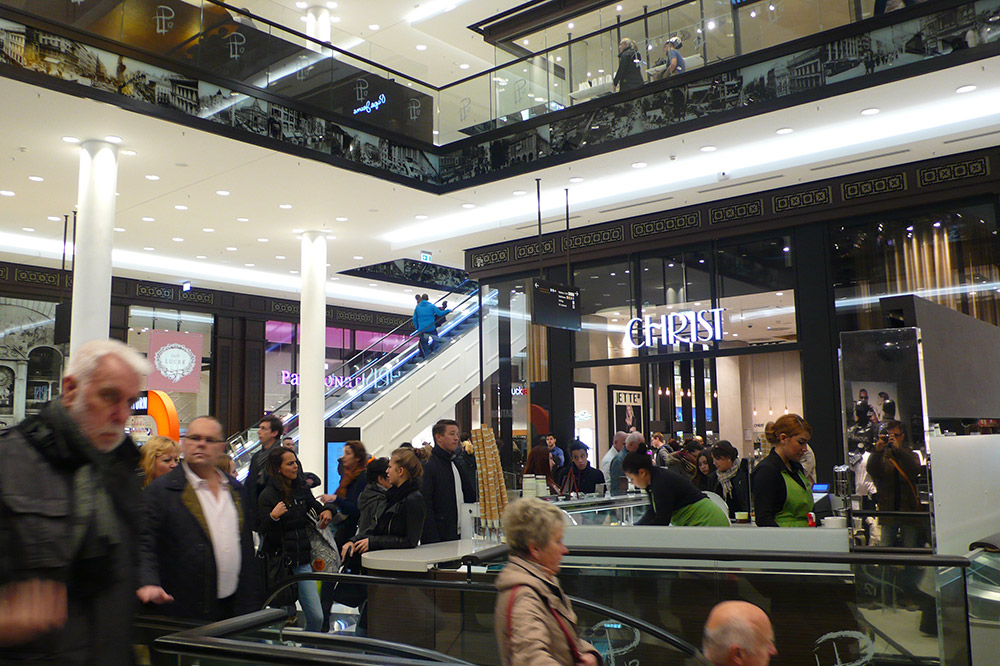
Redemption in the lobby: Christ manifest as purveyor of fashion accessories
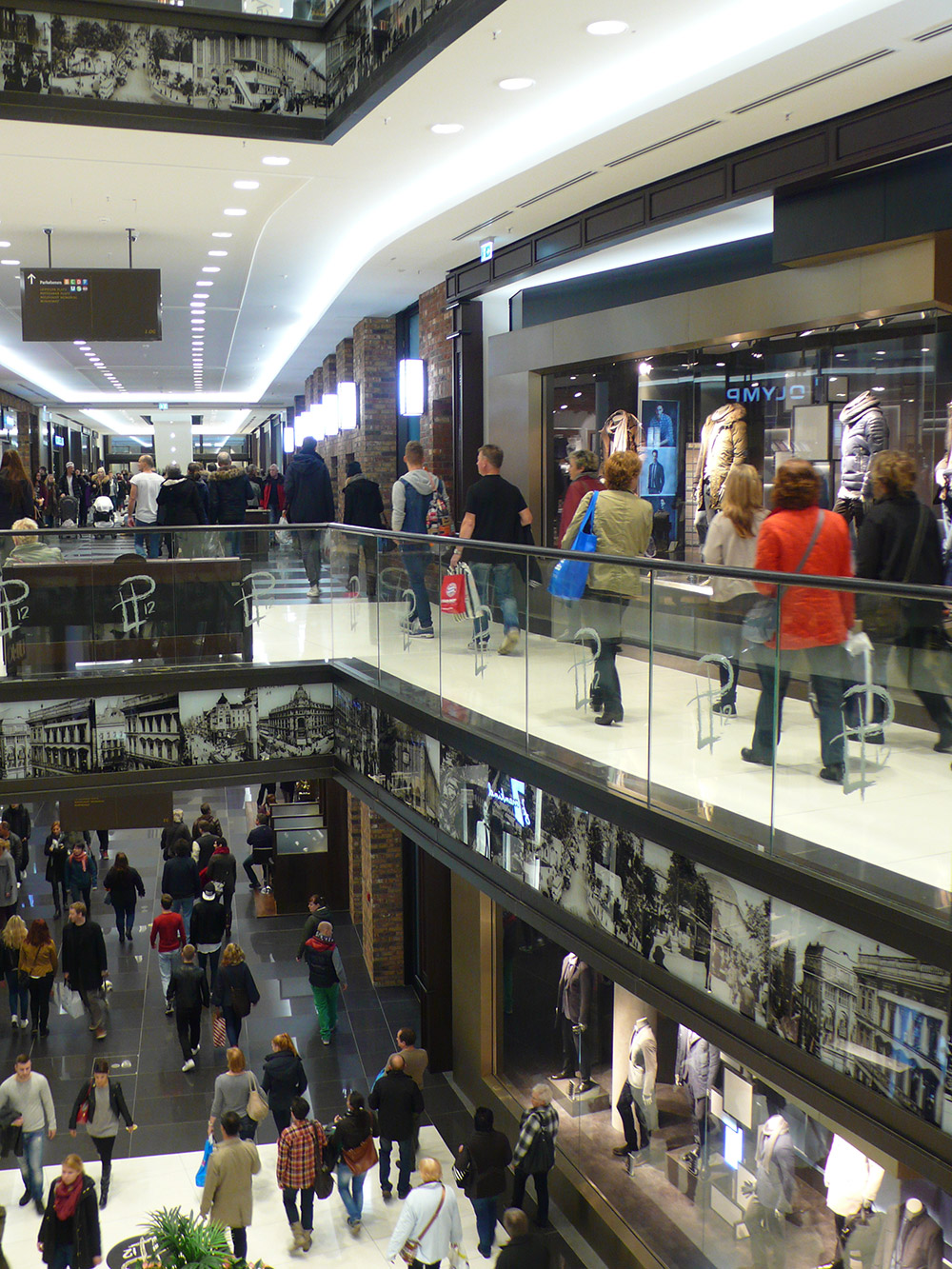
Split-level möbius shopping strip.
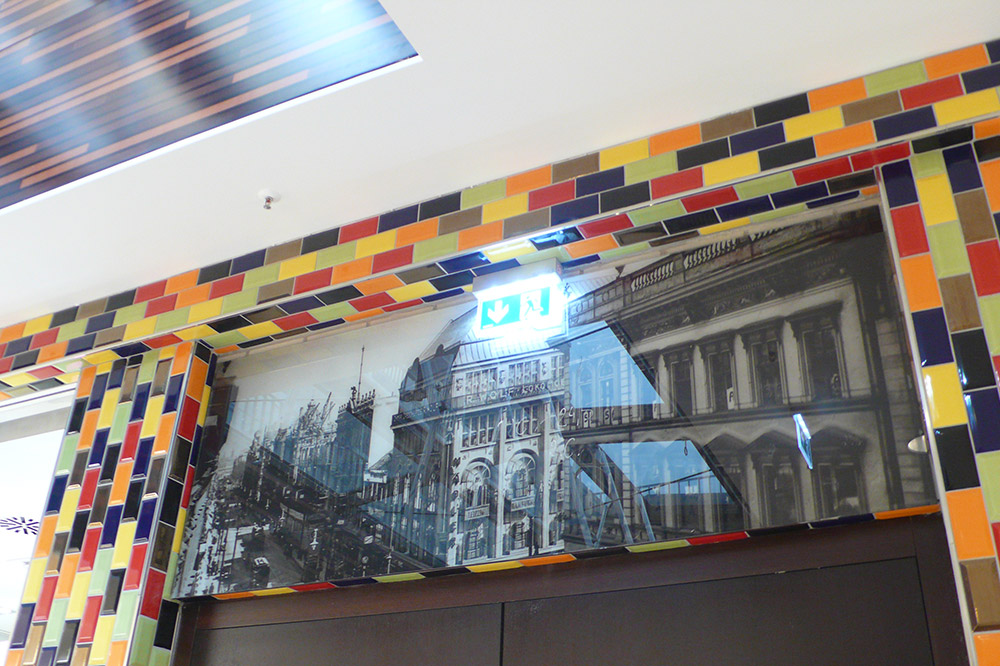
Fake wood slats emphasise slattyness rather than woodiness.
If there is an incandescent pulling mechanism, then there are other devices working on deceleration. For example, floor-coverings oscillate between stretches of multi-coloured and monochrome tiling, arranged alternately as solid blocks, as stripes or checker-board-fashion. Sections of wall flare up like ceramic harlequins or simulate exterior walls with stick-on brick coatings. It’s the re-deployment of razzle-dazzle camouflage, used with the same intention: not to render invisible, but to distort angles of orientation, and to scramble the sense of depth perception in the onlooker.
Old photographs of the Wertheim building perform similar tricks with the flow of history. Appearing as long friezes or as floor-to-ceiling reproductions, the black and white images pinch the second half of the twentieth century out of the flow of time. This acknowledgement of historic acquaintance is a bankrupt attempt to cast the Mall of Berlin as a spiritual entity rather than merely a corporal one: as an uninterrupted continuation of what went before, and therefore in full possession of a soul which never went away. It is the mall reincarnate. But what has come back?
In one section, a wall is a free-for-all community blackboard, dense with the chalky scrawl of tweens: all hearts, names, erasures, greetings to absent friends, occasional profanity and surprisingly few dick drawings. I stop here to admire this unexpected moment of interior-design anarchy, this concession to self expression in a control-zone of identity-by-proxy. Whilst contemplating the logistics of it all (who wipes the slate clean? how often?), that creeping unease from outside returns. What came to mind was the image of a wall covered in missing-person notices, written by desperate hands after the attacks on the World Trade Center. Mirrored in fiction, the image returns a year later in Danny Boyle’s film 28 Days Later, in which a bike courier awakens in hospital one month after a mutated virus zombifies the population of Great Britain. The clue is unmistakable.

left: 28 Days Later, 2002; right: Dawn of the Dead, 1978
It was George A. Romero’s 1978 film Dawn of the Dead that first linked shopping and zombies by setting his film in Pennsylvania’s Monroeville Mall. The film follows a group of zombie-apocalypse survivors as they take shelter in a mall, violently ridding it of the undead before settling in with a bit of recreational plunder. The characters speculate that zombies flock to the mall because of deep-seated instincts which have somehow survived death. The critical thrust of the film resides in the idea that shopping has become an inherent, inborn tendency. At the same time, the survivors remain unaware of the irony that they were attracted to the mall themselves for the very same reason. On the brink of death, one of the characters says “I’m gonna try not to come back”. He meant to life, of course, but it’s what I was thinking too whilst roaming the aisles of the Mall of Berlin.
I observed a lot of zombie-vacant mugs in the Mall, to be sure. I was probably one myself. But for every long-faced sad-sack jammed into a winter coat, schlepping their way through another Saturday afternoon at the mall, there were at least two or three mall-pros, or mall-natives, or alpha-mallers. These are tanned guys in machine-distressed jeans and t-shirts screen-printed in Bangladesh with fictitious shipping instructions, or counterfeit seals of authenticity. Their hair is gelled back into mall-odynamic helmets, and all have been savvy enough to leave their winter gear in the car in the basement. Twelve-year-old girls navigate the terrain with ease too; as yet unfettered and unflummoxed by the glare and manifest cynicism of the Ghandi, Reagan, Merkel and Constitutional Basic Law quotes etched into brass plaques at the foot and head of each escalator.
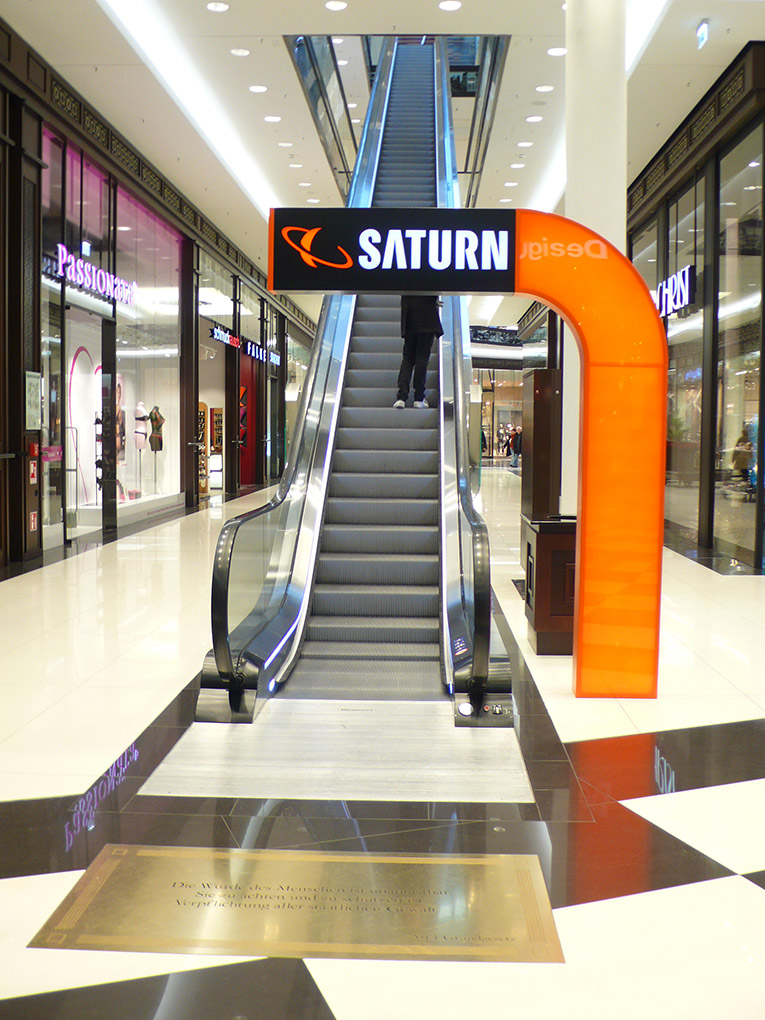
Article 1 of German Basic Law marks the direct escalator to Saturn (an electronics store): “Human dignity shall be inviolable. To respect and protect it shall be the duty of all state authority”.
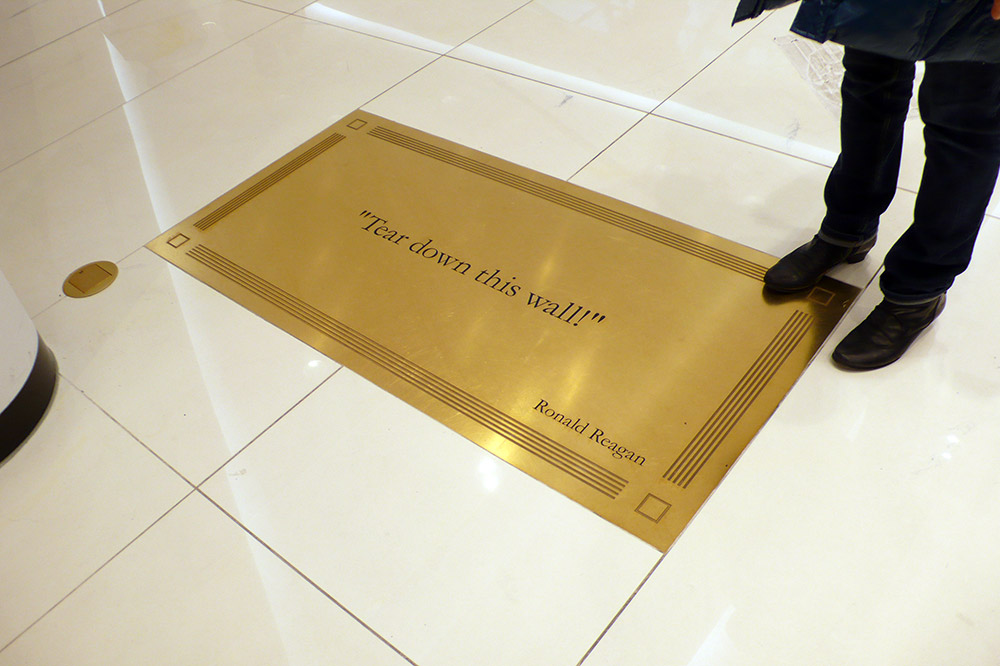
Did you say “mall”? Reagan’s 1987 petition to Gorbachev: no détournement required.
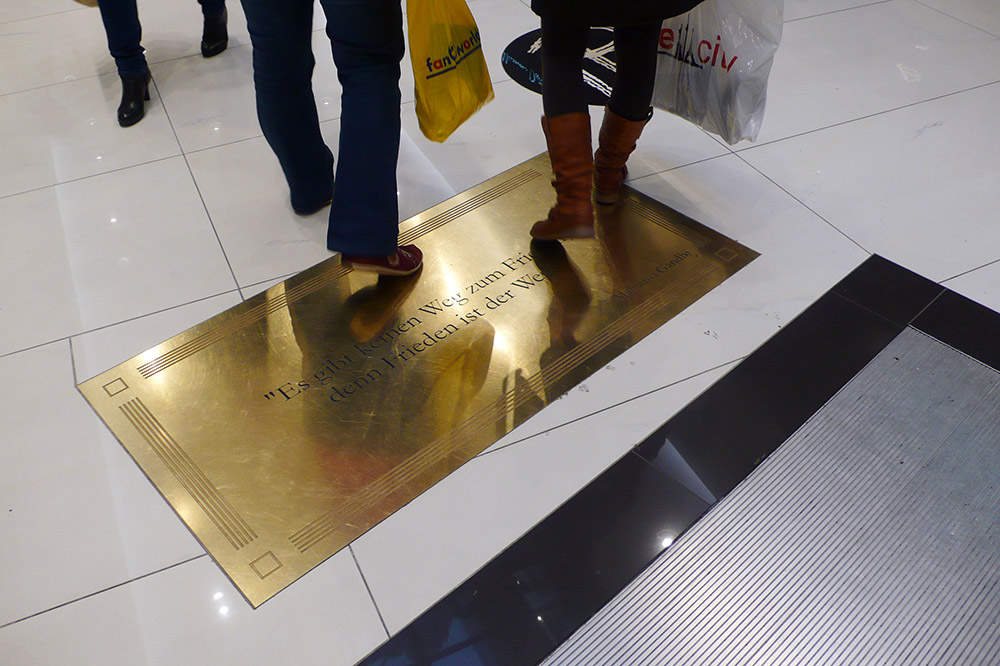
Yeah, let’s walk all over the words of Gandhi, and take our freedom back home in a plastic bag. Oh, and do typographically incorrect quotation marks dim a statement’s validity? The symbol for inches has been used rather than German marks („korrekt“) or English ones (“correct”).
It seems clear to me that shoppers aren’t the zombies at all, even though they’re still going through the motions. They’re just polite funeral guests who’ve stumbled into a christening, and have arrived too late anyway because they spent too long curating their Amazon customer reviews and Yelp profiles. The Mall of Berlin is a corpse risen from the grave: a zombified department store invoked from the beyond by shamans of the market in mysterious voodoo-capitalist ceremonies. Here it lumbers and flails in the land of the living, just another epidemiological vector in the pathogenic spread of Berlin malls: sixty already lurk in the city, with more planned. In Horror in Architecture, Joshua Comaroff and Ong Ker-Shing describe the scene:
“Take the zombie, whose body continues to labor under a horrid automatism after the soul and intellect have been evicted.”
In establishing his concept of the modern myth, Roland Barthes described a “peculiar” system, grafted to a semiological-predecessor, in which signs (black and white photography, in the case of Mall) are reduced to a signifying function when “caught by myth”. In an eviction of another kind, Barthes suggests that the meaning of the form “empties itself”, becomes impoverished, with the result that “history evaporates”. This suggests that the Wertheim photos, taken with documentary intent, have, along with the political quotes with their botched speech-marks, and – hell, why not – all of LP12, transmogrified into a system of what he calls “depoliticized speech”. Myth, Barthes says
“… abolishes the complexity of human acts, it gives them the simplicity of essences, it does away with all dialectics, with any going back beyond what is immediately visible, it organises a world which is without contradictions, because it is without depth …” — Myth Today, in Mythologies, 1957
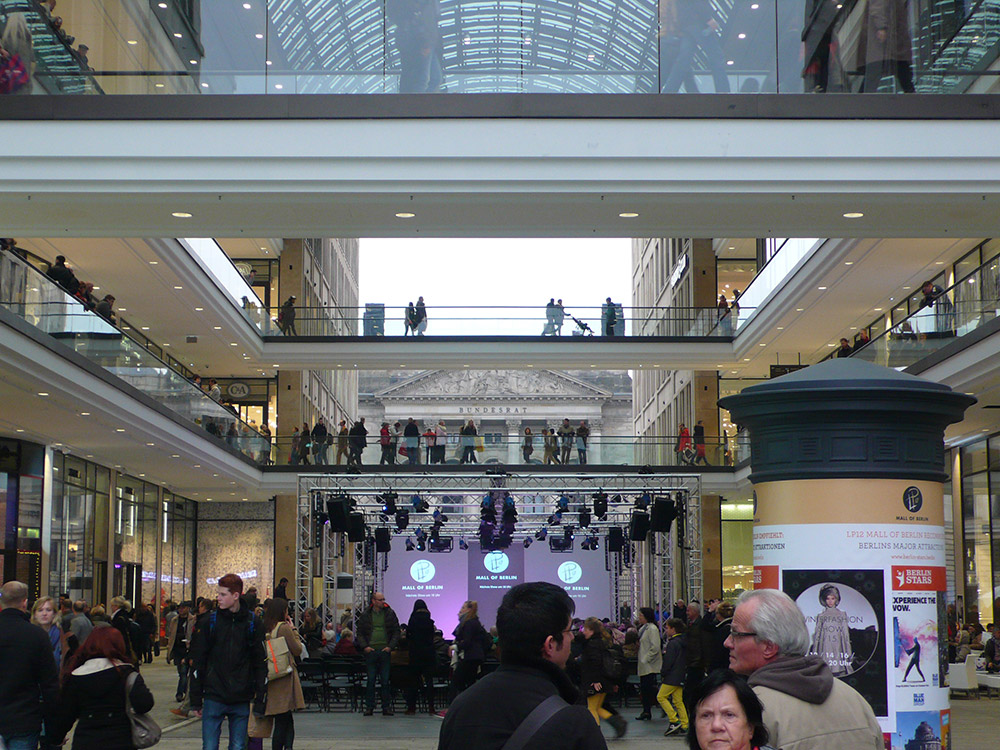
Keeping an eye on depoliticized speech: the German Bundesrat (Federal Council), prominently framed by the Mall of Berlin’s atrium.
The investor, Harald G. Huth, labouring under horrid automatism himself, has partially moved on. Not far away in fact. His company, HGHI (High Gain House Investment — I shit you not) is to build another mall in Berlin’s north-west district of Moabit, where residents have already sued the district council. Meanwhile, the general contractor, Fettchenhauer Controlling & Logistic, is insolvent and is also being investigated for fraud. Scores of subcontractors’ invoices were left unpaid, and thirty Rumanian building workers who hadn’t seen wages since June 2014 protested in front of the Mall in December. Shops were then ordered to turn off their music in case the fire alarms couldn’t be heard. Sometimes they would ring for no reason. In a press conference, Huth claimed that a series false alarms was proof that the fire-detection technology worked. It was also discovered that smoke exhaust flaps in the upper floor were faulty and that the systems for automatically alerting the fire services didn’t work. One unnamed building contractor reported that during construction, 3500 openings for ventilation and water circulation had been forgotten, and subsequently had to be retroactively core-drilled from solid concrete.
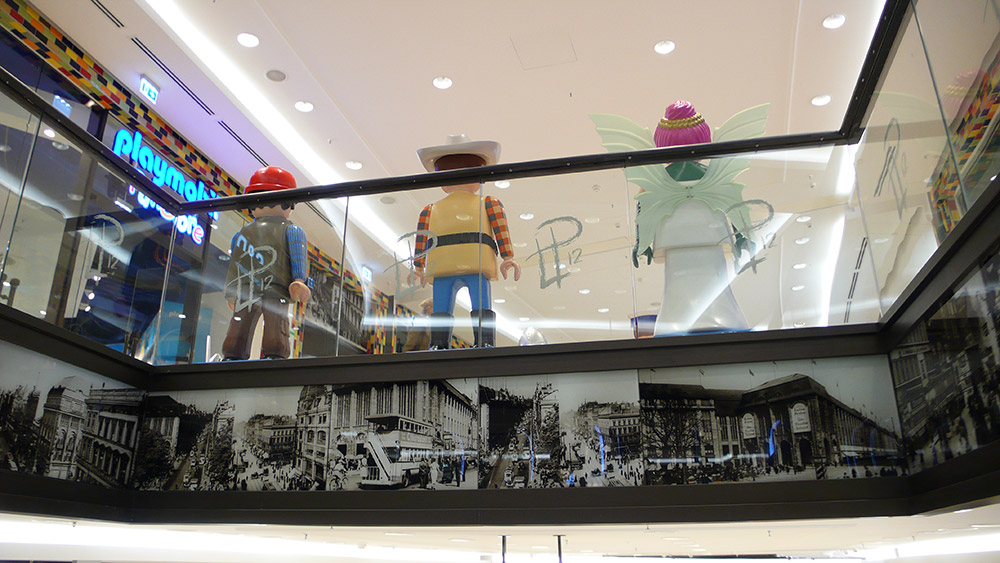
Avatars of adult professions (builder, cowboy, celestial being) preside over avatars of historic meaning.
The Mall of Berlin arrives at a time where Berlin-hype is on the wane, and internationally, malls seem to be too. Abandoned shopping complexes contribute to a daily stream of online ruin-porn. In 2014, Business Insider’s correspondent for retail-doom, Hayley Peterson, dispatched several reports to this effect, embracing words like “extinct” and “haunting” in recounting their “slow, ugly death”. In the UK, entrepreneurs are busy picking over the carcasses. Zed Events organises immersive zombie-apocalypse experiences in Friar’s Walk mall in Reading where yesterday’s shoppers can role-play as survivors, military personnel or as walking dead, figures currently only partly available in the Playmobil store on the second floor.
My most recent visit, on a Tuesday evening, drew me to the basement. The colour scheme was more muted down here. The candy-coloured tiles of the upper floors had taken on a pallid hue, as if decay had long set in, and the wood-look ceiling slats pressed down like a coffin lid.
Just two other customers were drifting around like leaves in the redundant courtyard above. The place was, figuratively, dead. I’d abandoned my mission to buy replacement winter gloves: the manic taxonomy of items in one store was as bewildering as the lack of choice in another, and besides, shopping without a crowd offered no protection from the twangy attention of under-tasked shop managers. Instead I wafted passed store after store, each one more superfluous than the next, each one staffed by a lone sales assistant peering into the transparent window of a smartphone screen, beyond which the jostle and chatter of a vibrant crowd reported back with tidings from the land of the living.
